Month 12:29, Week 4:7 (Shibi'i/Sukkot), Year:Day 5955:353 AM
2Exodus 7/40
Gregorian Calendar: Friday 12 March 2021
Return of the Elijah Prophets
VII. The Book of Daniel III
- Its Historicity Proven
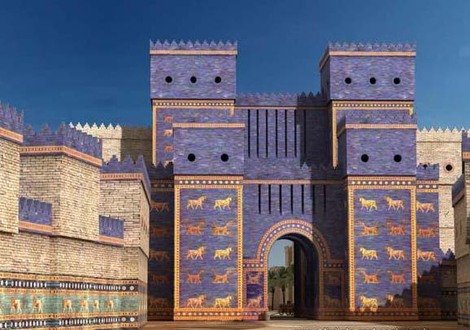
Continued from Part 5
Introduction
Shabbat shalom kol beit Yisra'el and Mishpachah and welcome back to the seventh - and for now, the last - part of our series on the Elijah prophets and the third part on the Book of Daniel. We shall, Yah willing, return to this series some time after the Passover Season. It's also the last sabbath of the year and an appropriate place to stop for a while.
Review of Part VI
Last week we examined alleged Greek and Persian 'loan words' and found they were no such thing. We also compared Daniel with a known forgery, the Book of Judith, to see just how different authentic histories look alongside forged ones. I promised you that today we would look at the secular records of Babylon for proof that Daniel and his three friends were actual historical figures. And the first thing we learn, from Daniel 1:6-7, is that the Judahites' new masters renamed their captives with Babylonian names containing the names of their pagan gods:
"Now from among those of the sons of Judah were Daniel, Hananiah, Mishael, and Azariah. To them the chief of the eunuchs gave names: he gave Daniel the name Belteshazzar; to Hananiah, Shadrach; to Mishael, Meshach; and to Azariah, Abed-nego" (Dan.1:6-7, NKJV).
The Babylonians Change the Hebrews' Names
If we are to make sense of these names and the names in the Babylonian records, you must first of all remember that Israelites were forbidden by the Torah to name the names of foreign gods, let alone write them down, or incorporate them in their names which would be spoken out aloud every day, as it is written:
"And in all that I (Yahweh) have said to you, be circumspect and make no mention of the name of other gods, nor let it be heard from your mouth" (Ex.23:13, NKJV).
Did Saul Give His Children Terrible Names?
Let me give you an actual example from the days of King Saul since we were recently discussing him and the 'wild west' that that time was earlier on in this series. In the Bible you will find one of his sons called "Mephi-bosheth" (2 Sam.4:4, NKJV) [1]. This is a very strange name to call someone, the word mephi meaning 'utterance' and bosheth 'shame' or 'disgrace' - in other words, his Dad apparently called his son 'utterance of disgrace'. Another one of Saul's sons was called 'Ish-bosheth', meaning 'man of shame'. What's going on here? Did Saul hate his children or what? What human-being, let alone a king, would call his new-born 'utterance of shame' or 'man of shame'? Now it's true Mephibosheth was a cripple, but he wasn't born that way - that occurred as the result of nis nurse dropping him when he was 5 years old and he became lame as a result of the fall (2 Sam.4:4). But that was 5 years after he was born...and his brother Ishbosheth was in perfect health. So that can't be the reason...an outburst of disgust at having a lame child.
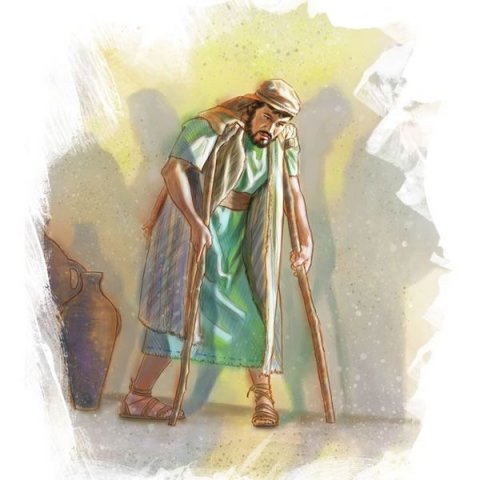 Mephibosheth, the lame son of Saul, whose
Mephibosheth, the lame son of Saul, whose
strange name meant 'utterance of shame'
Benoni vs. Benjamin
We remember that Rachel gave her second-born child a horrible name, Benoni, meaning 'son of my sorrow', because she was dying in child-labour, but Jacob fortunately changed that afterwards to Benjamin, meaning 'son of my right hand' (Gen.35:18).
Mephi-bosheth or Mephi-baal?
So these are real names in the Book of Samuel, yet in 1 Chronicles these boys are called 'Mephi-baal' and 'Ish-baal', not Mephi-bosheth and Ish-bosheth! Why the difference? Well, in the days of Samuel the word baal simply meant 'lord' or 'master' in much the same way English-speakers used to refer to barons and other nobles as 'my lord'. Unfortunately, Baal was also - sort-of - the proper name of the pagan Canaanite deity 'Ba'al' just as the English-speaking world called Yahweh, 'LORD'.
The Upset Compilers or Editors
The later compilers of Chronicles, or perhaps even later editors than them, took exception to a pagan deity being used in an Israelite king's sons names in Scripture, and changed the names euphemistically to 'Mephi-bosheth' and 'Ish-bosheth' as if to express their disgust because, in their minds, it was a shame and disgrace that such names had ever been used. (Why they didn't insert 'Yah' or some cognate is unknown but perhaps they would have regarded such an action as an unacceptable, deliberate falsification). Whether Saul was right or wrong to use the name of 'baal' we may never know - it may be because of the lawlessness of those days (and the general ignorance of Torah back then) or it may be that the language changed (or at least attitudes toward it) later on in Israel's history. Either way, the names got changed in order to make the scriptural record more Torah-compliant so as not repeat the names of demons or foreign gods in sacred text for others to then read out aloud in devotionals! That's why, in Young's Concordance, for example, 'Mephibosheth' is simply translated, with hindsight, as 'utterance of Baal'.
How Daniel Dealt With Pagan Babylonian Names
The reason I have gone to all the trouble to share this piece of linguistic and historical knowledge is because something similar has undoubtedly taken place in Daniel too. You can imagine how upset Daniel and this three friends must have been to learn they were being given new names that included heathen deities in them! For to speak them, to an Israelite, would be the same as actually invoking those demon-gods and thereby giving honour to the pagan deities. How he and the lads dealt with that we don't know - they may simply not have any choice but to use the names Nebuchadnezzar's chief eunuch gave them. However, that wasn't true of Daniel's private writings, including his Book which would become Scripture - the Book of Daniel - where there are some very strange names to be found indeed which the sceptics use as evidence that the Book was forged. There he could write as he pleased, and as we shall see, he did, so as not to offend Yahweh in disobeying a mitzvah (commandments) not to repeat a demon's name.
The Talmudists Change Yah'shua's Name
The Jews still do the same thing today. If you read the Talmud you'll see that the rabbis hated the Name of the Saviour so much that instead of referring to Him by His proper name 'Yah'shua' (Hebrew) or 'Yeshua' (Aramaic) they invented a new name by truncating the Aramaic it to 'Yeshu', a name nowhere to be found in archaeology.
How Daniel Changed the Names of the Babylonian Gods
I have constructed a table for you (below) to help you follow the sometimes involved linguistic ranifications of what I want to share now.
Two of the most prominent gods of the Babylonian pantheon were Bel (the chief of their gods) and Nebo, and are definitely visible in Daniel's and Azariah's Babylonian names, Bel-sar-uzzur (and the abbreviated Belshazzar, which you'll remember was also the name of a later Babylonian king) and Ardi-Nabu, respectively, though slightly modified by Daniel so as not to offend Yahweh and his own conscience to "Belteshazzar" and "Abednego", respectively, in the Bible. Another of the dirty Babylonian deities, Marduk, is less obviously present and therefore this interpretation of mine is open to debate, but may may well appear, highly truncated, in two known forms of Mishael's Babylonian name, Meshallim-Marduk and an abbreviated version, Meshaku. Daniel has simply dropped the 'u' of the abbreviated form and recorded it as "Meshach" or more accurately, "Meshak". Finally, Hananiah's Babylonian name, Shuduruku, may or may not honour a Babylonian deity (I'm not sure) but I'm guessing it does because of the way Daniel has changed it to "Shadrach".
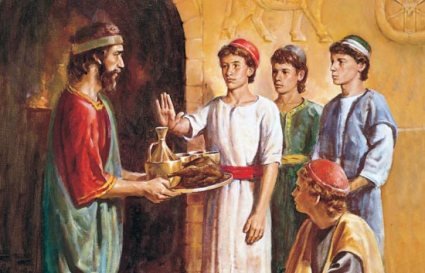 Daniel and the three young Hebrew men -- all rose to prominence
Daniel and the three young Hebrew men -- all rose to prominence
Hananiah / Hanunu
You'll notice that I have also included the Babylonised version of Hananiah's name, Hanunu, and I have done that because Hananiah would later become so famous that his name is also found recorded in the secular Babylonian records with the Babylonian spelling of his Hebrew birth name as well as the name given him by the head eunuch, Shuduraku (Shadrach). That is extremely rare because the Babylonians went to great efforts to culturally assimilate their war captives, and changing their original names was the first major step towards obliterating their former identities. What's remarkable about this side of his history, which I'll tell you about in a minute, is not recorded in the Bible but it is recorded in the Babylonian secular records! You'll see how the Bible comes even more to life with the aid of these ancient cuneiform tablets discovered before the last war.
How Names Change Between Languages
Don't be surprised by all these name variants because this is common historically when names are borrowed across languages. Take the English name 'John' which comes from the Hebrew Yochannan. In Christian nations over the past 2,000 years numerous Hebrew names have been adopted and changed. John or Yochannan is one of them. He's known as Johannes, Jon, Jan, Jonas, and Johan in the Germanic nations such as here in Sweden and in Germany, as Guiseppe in Italian, Seán or Shaun in Gaelic, Juan in Spanish, Ivan or Vanya in Russian, Janek in Czech, Ian in English, and so forth. In fact, there are dozens of variants of the name John! And you all know how the Saviour's Name, Yah'shua, has numerous variants from Yehoshua to Yeshua to Jesus. Sometimes sounds in one language aren't available in another so alternatives have to be used, or the grammar demands that the endings have to change.
Name Tweeking and Changing
Take Daniel's given Babylonian name of Bel-sar-uzzur which literally means '[The pagan god] Bel protect the king' (in this case, Nebuchadnezzar, of course), a bit like our 'God save the King!'. It's not a huge leap of understanding to realise that Belshazzar is a shortened form of Bel-sar-uzzur. Mishael seems to have been directly transliterated to Meshaku. Remember, the chief eunuch at court has made these names up - his job was presumably to rename all the foreign captives pressed into the direct employment of the king. Some names must have sounded similar in Babylonian and so they were slightly tweeked to make them fit in. Some had no equivalent and so a completely new name was given.
Witnessing to Vietnamese
When I witnessed to Vietnamese boat people refugees in Oxford (in the 1970's) who barely spoke any English and were struggling with their new language - I had to communicate in broken French with them at times as Indochina had formerly been a colony of France. Mostly, though, I used this dual Vietnamese-English New Testament but as 'Chris' or 'Christopher' was not a name in the Messianic Scriptures with a Vietnamese translation, and as there was a danger of calling me the nearest thing, which was 'Christ', we gave up and on their own initiative they simply gave me a new name, 'Hung', meaning 'strength' and tried (unsuccessfully, I might add) to teach me some Vietnamese. (Interestingly enough, the first Chinese Christians didn't know how to translate the name 'John' and instead used their word for 'strong' instead). Anyway, as far as my Vietnamese friends were concerned, that was that. I was Hung or 'Strong' thereafter. My point is, with the problems that different languages cause, thanks to the division of tongues at Babel, all sorts of adaptations have to be made particularly in the use of names, so we should not be surprised to find conversions from Hebrew to Babylonian causing difficulties for Nebuchadnezzar's chief eunuch.
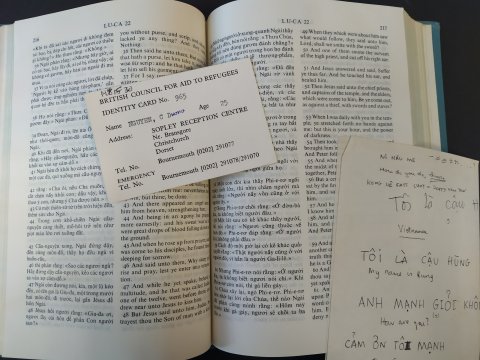 My early attempts to witness to Vietnamese refugees in Oxford
My early attempts to witness to Vietnamese refugees in Oxford
Spoiling Babylonian Names
So what we have here in our Bibles is Daniel deliberately spoiling the Babylonian names so as not to give their demon-gods any sort of glory and so make him a transgressor of the mitzvah (commandment) of Exodus 23:13, something Western critical scholars, unaccustumed to living under the Torah as they are, would naturally miss or ignore. So instead of charging Daniel with deception for changing the names - or rather the alleged 'forger' for getting the names 'wrong' - we need to undestand what's going on here in the clash of cultures between the Israelite exiles and their new Babylonian masters. Daniel is simply doing the honourable thing.
| Hebrew name |
English Meaning |
Jumbled OT Name |
Actual Babylonian Name, Transliteration and/or Translation |
| Daniel |
El (God) is my Judge |
Belteshazzar |
Bel-sar-uzzur = 'Bel-shazzar' = Bel protect the King |
| Hananiah* |
Yah[weh] is gracious |
Shadrach |
Shuduraku = Hanunu |
| Mishael** |
Who is like El (God)? |
Meshach/Meshak |
Meshaku = 'Mesha[llim-Mardu]k' |
| Azariah |
Yah[weh] has helped |
Abednego |
Ardi-Nabu = Servant of Nebo |
*His Hebrew name was also recorded on a Babylonian monument as Hanunu
** Mishael (Heb.) Was a direct equivalent of Meshaku (Bab.)
Two Separate Belshazzars in the Historical Record
Now we come to the interesting part - the historical proof that Daniel and his three friends existed and that they were around in the 6th century BC as the Book of Daniel claims. That being the case, the book is not a forgery and the incredible things recorded in it - the miracles and prophecies - suddenly become the more credible. Now if Daniel's Babylonian name is Belshazzar (which he wrote as Belteshazzar, so as to obscure the 'Bel' part), then we should expect at least two Belshazzar's from this period of Babylonian history - Daniel himself and the King of the same name mentioned in Daniel chapter 5 at the feast when the hand wrote supernaturally on the wall declaring his doom. Well, not only do the secular Babylonian records speak of two Belshazzars but they also clearly differentiate between them.
Daniel on the Cuneiform Tablets
The inscription that mentions our Daniel is numbered YBC 3765 and is to be found in the Babylonian Collection at Yale University. It was translated and published in 1929 by P.Doughtery. Not only that but the scholars of the time clearly understood that the Belteshazzar of the Book of Daniel and the Balshazzar of the tablet were one and the same. The second inscription of importance is to be found at the Archaeological Museum of Florence, Italy, No. #135, being translated and first published in 1960 by K.Oberhüber. This is what the Yale inscription says:
"[As to] one mina (and) seventeen shekels of silver, which are in one shekel pieces, belonging to Belshazzar (Bel-sar-user), the chief officer of the king (amel shaqu sharri), (charged) against Rimut, the son of Enlil-kidinnu..."
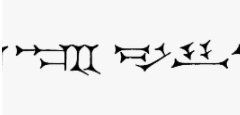 Belshazzar in Babylonian cuneiform
Belshazzar in Babylonian cuneiform
Royalty and Patronyms
That was a huge sum of money in those days. The important words to notice here are amel shaqu sharri, the chief officer of the king, because it isn't a title ever held by a royal prince. Had this Belshazzar been the same as the royal Prince Belshazzar of Daniel chapter 5, the grandson of Nebuchadnezzar, he would have had a royal patronym appended to his name showing his royal lineage, as is the case of the others mentioned in the inscription. But not this Belshazzar - only his job title is recorded, the same one mentioned in the Bible.
Amel-Marduk is Evil-Merodach
We see the same thing in the Florence tablet which has been dated to the middle of 560 BC. Yet again Belshazzar is without royal patronym and having the same title, shaqu sharri, chief officer of the king. Who is the Babylonian king in question? A man called Amel-Marduk whose name apprears in the Bible as Evil-merodach in 2 Kings 25:27 and Jeremiah 52:31. Let me read you the second of those references where you will again see another example of a foreign name with a pagan deity in it being mutilated by Jeremiah for exactly the same reason Daniel changed his own Babylonian-given name:
"In the thirty-seventh year of the exile of Jehoiachin king of Judah, in the year Evil-Merodach (Amel-Marduk) became king of Babylon, he released Jehoiachin king of Judah and freed him from prison on the twenty-fifth day of the twelfth month (4 days ago in the Creation Calendar). He spoke kindly to him and gave him a seat of honour higher than those of the other kings who were with him in Babylon. So Jehoiachin put aside his prison clothes and for the rest of his life ate regularly at the king's table. Day by day the king of Babylon gave Jehoiachin a regular allowance as long as he lived, till the day of his death" (Jer.52:31-34, NIV).
Amel-Marduk's Assassination
If King Balshazzar of Daniel 5 was the grandson of Nebuchadnezzar, then Amel-Marduk (Evil-Merodach) was his son. (The reason he treated Jehoiachin so nicely we'll discuss at another time). Amel-Marduk was assassinated by his brother-in-law, Neriglissar, and it is precisely in this year of Neriglissar's coup d'état that Daniel disappears from the Babylonian picture, as you might expect, only to re-emerge 21 years later during the regency of his namesake, Prince Belshazzar. So what happened was that Daniel continued under Amel-Marduk in the same office he had held under Amel-Marduk's father, Nebichadnezzar, but was passed over by the usurper Neriglissar who probably surrounded himself with his own men whom he trusted.
Belshazzar the Crown Prince
And now to another tablet, No. #322 from the state archive at the Temple of Erech which records a tithe paid to the pagan temple by the royal prince Belshazzar, but more than that - he is called "Bel-sarusur mar sharri = Belshazzar, the crown prince", clearly distinguishing him from Daniel, the other Belshazzar but without the royal patronym.
Third in the Kingdom for One Night
Now I could give you more evidence but I'll leave those who are interested to read Dr.William Cooper's book, The Authenticity of the Book of Daniel (2012). Prince Belshazzar is mentioned in other records like the clay cylinders found at the temple of Sin, the moon god, the one Abram would have worshipped before Yahweh broke into his life and took him west to Canaan, and these cylinders contain similar royal patronyms. So it is clear the two Belshazzars were contemporaries, at least for a little while - one was a royal Prince who would go on to become King and the other the chief court officer of the kings Nebuchadnezzar and Amel-Marduk, and then, after a long interval, and only for a day, be consulted and promoted by the other Belshazzar too to be "third in the kingdom" (Dan.5:29, NRSV), one of the shortest terms of office ever.
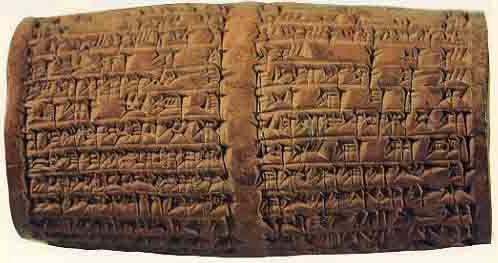 Example of a cuneiform cylinder from the time period
Example of a cuneiform cylinder from the time period
The Three Youths Promoted to High Office
We will end with the evidence for the existence of the three friends of Daniel by taking you back to chapter 2 in the time of King Nebuchadnezzar after his revelation about Yahweh and his restoration to the throne, where we read, starting at verse 48:
"Then the king (Nebuchadnezzar) promoted Daniel, gave him many great gifts, and made him ruler over the province of Babylon and chief prefect over all the wise men of Babylon. Daniel made a request of the king, and he appointed Shadrach, Meshach, and Abednego over the affairs of the province of Babylon. But Daniel remained at the king's court" (Dan.2:48-49, NRSV).
The Story of Hanunu
Let's get straight into the nitty-gritty. All these names were known anciently and are to be found in the same records we have been examining with slight spelling differences. As we have seen, Shadrach was spelled Shuduraku in Babylonian, and Meshach was merely the Babylonian/Assyrian name Meshaku. It seems, though, that Shadrach was very unhappy about using the pagan name given to him by that chief eunuch even in his official capacity as one of the ministers in Babylon - we just read of his appointment in Daniel 2:49. So determined was he to have his original Hebrew name back - Hananiah - that we find it recorded in a Babylonian inscription in its Babylonian spelling, Hanunu. Had he not been a man of great political power, that would have been a very dangerous thing to do indeed. It was nothing less than an act of defiance. The fact that the king did nothing about it shows the immense influence he came to wield, possibly acquiring the power once held by Daniel after his death. But how did he acquire this influence? Why would the king have given him this special consideration?
The Istanbul Prism & Babylon's Top Court Officials
This brings us to a remarkable document, the Istanbul Prism (IM 7834), a 5-sided clay cylinder with 5 columns of text. The first line of the first column is what interests us because it contains a list of the names of Babylon's top court officials known as the mashennim. There's a similar list officials in Daniel 3:2, incidentally, who were present at an important event called the Convocation of Dura. What was so special about that convocation? It concerned the setting up of an image on the Plain of Dura just outside Babylon, most likely to the chief god Marduk, and Nebuchadnezzar's insistence that all his subjects, and especially these officials, bow to the image as a show of loyalty to both god and king:
"And King Nebuchadnezzar sent word to gather together
- 1. the satraps,
- 2. the administrators,
- 3. the governors,
- 4. the counselors,
- 5. the treasurers,
- 6. the judges,
- 7. the magistrates, and
- 8. all the officials of the provinces,
to come to the dedication of the image which King Nebuchadnezzar had set up" (Dan.3:2, NKJV).
The inscription on the Istanbul Prism has a parallel list as follows:
- 1. The Court Officials (meshannim);
- 2. The rabuti of Akkad;
- 3. Town officials;
- 4. District officials; and
- 5. Western vassal kings.
Hanunu, Chief of the Royal Merchants
We're interested in the first of these, the meshannim or court officials, those closest to the king. 12th in the list is Ardi-Nabu, who was the sipiru or secretary to Amel-Marduk, the son of Nebuchadnezzar and Crown prince; and 18th on the list...wait for it...is none other than HANUNU, chief of the rab tamkari or royal merchants! These were positions of the greatest trust.
Mushallim & Mishael
Notice, if you will, that Mushallim is the Babylonian form of the Hebrew name Mishael; Ardi-Nabu means 'Servant of Nebo', and is the original Babylonian form of the Hebrew Abed-nebo, which holds the same meaning, but which in this case was deliberately corrupted by Daniel to the meaningless 'Abed-nego' - we'll talk more about him another day.
Concealed from the Public
Lastly is Hanunu, chief of the royal mecharnts, which as I said is the direct transposition into Babylonian of Shadrach's Hebrew name, Hananiah. This is an extraordinary authentication of the Book of Daniel and its faithfulness to the historical record. The extraordinary thing is that the public have never got to hear about it. Had they done, the West might not have gone down into the modernist abyss of atheism quite so quickly as it did. Imagine what might have happened had this been taught in history and religious knowledge classes in the schools and universities?
The Family of Abednego
Ardi-nabu or Abednego is found in other inscriptions too so there are many witnesses. Indeed they are so detailed that we can build up a picture of Azariah's household, the family he raised during the Captivity. We know all about the house he rented, the meals he paid for, and most interestingly of all, about his son called Baldatu in Babylonian, a grandson and a slave which came along with the office. which he held, and the slave was doubtless treated well. Another son called Nana-ah-iddin organised the building of a canal. I only have time to very quickly sum the information up. You can dig further and learn more about the kind of life these Hebrews lived in Babylon.
More of the Series Another Time
Yet the modernist critics would have you believe that these four men, all of whom are well documented, are works of fiction. Last week we saw how ridiculously impossible this liberal fiction is. I wanted to talk to you about the evidence for the fiery furnace and the giant image, which we briefly touched on, but alas I have not been well and did not have the strength to prepare more for you, which is why this talk is a little shorter than usual. There's so much more but alas we must end this series of teachings on the nevi'im (prophets) for now. If Yahweh grants me more time and better health then by His grace I will complete this series on the Book of Daniel and on the Elijah Prophets as a whole at a later date. There never seems to be enough time, though. I most of all wanted you to know that the Bible - and in particular the Book of Jeremiah - is founded on rock-solid historical evidence and that you can rely on it, in spite of attempts to suppress the truth. Those who have sought to dismantle and discredit it and hide the true data have a lot to answer for before the Judgment of Yahweh.
Conclusion
We shall assemble again, Yah willing, for the all-important New Year message at Rosh Chodesh in two days' time. I cannot underscore enough how important this is going to be this year. Huge historical changes are to get underway in two days' time and the forces of evil, which will do their utmost best to oppose them, are to be confronted head-on in the Spirit of the Elijah Prophets. Indeed we had a small skirmish the other day. Until then, may Yahweh bless and keep you all in Yah'shua's (Jesus') Name. Amen.
Continued in Part 8
Endnotes
[1] Also 2 Samuel 9:6,10-13; 16:1,4; 19:24-25,30; 21:7-8
Acknowledgments
[1] Harry Mowvley, Guide to Old Testament Prophecy (Lutterworth Press, Guildford & London: 1979)
[2] John Bright, A History of Israel, 3rd ed. (SCM Press, London: 1982)
[3] Bernhard W.Anderson, The Living World of the Old Testament, 2nd ed., 5th impression (Prentice Hall, Hew Jersey: 1976)
[4] E.W.Heaton, The Hebrew Kingdoms - New Clarendon Bible (OUP, Oxford: 1968)
[5] G.W.Anderson, The History and Religion of Israel - New Clarendon Bible (OUP, Oxford: 1976)
[6] Peter R.Ackroyd, Israel under Babylon and Persia - New Clarendon Bible (OUP, Oxford: 1979)
[7] D.S.Russel, The Jews from Alexander to Herod - New Clarendon Bible (OUP, Oxford: 1978)
[8] D.Winton Thomas (ed.), Documents from Old Testament Times (Harper & Row, NY: 1961)
[9] Othmar Keel, The Symbolism of the Biblical World: Ancient Near Eastern Iconography and the Book of Psalms (SPCK, London: 1978), translated from the German, Die Welt der altorientalischen Bildsymbolik und das Alte Testament: Am Veispiel der Psalmen (Köln: 1972)
[10] Clifford M.Jones (ed.), Old Testament Illustrations - The Cambridge Bible Commentary on the New English Bible (CUP, Cambridge: 1971)
[11] Matthew Black & H.H.Rowley (eds.), Peake's Commentary on the Bible (Van Nostrand Reinhold, Wokingham, England: 1982)
[12] Gerhard von Rad, Old Testament Theology, 2 vols (SCM Press, London: 1975), translated from the German, Teologie des Alten Testamentes: Die Teologie der historischen Überlieferungen Israels (München: 1957)
[13] David Pawson, Unlocking the Bible: A Unique Overview of the Whole Bible (Collins, London: 2007)
[14] Bill Cooper, The Authenticity of the Book of Daniel (Creation Science Movement, UK: 2012)


V256
|


